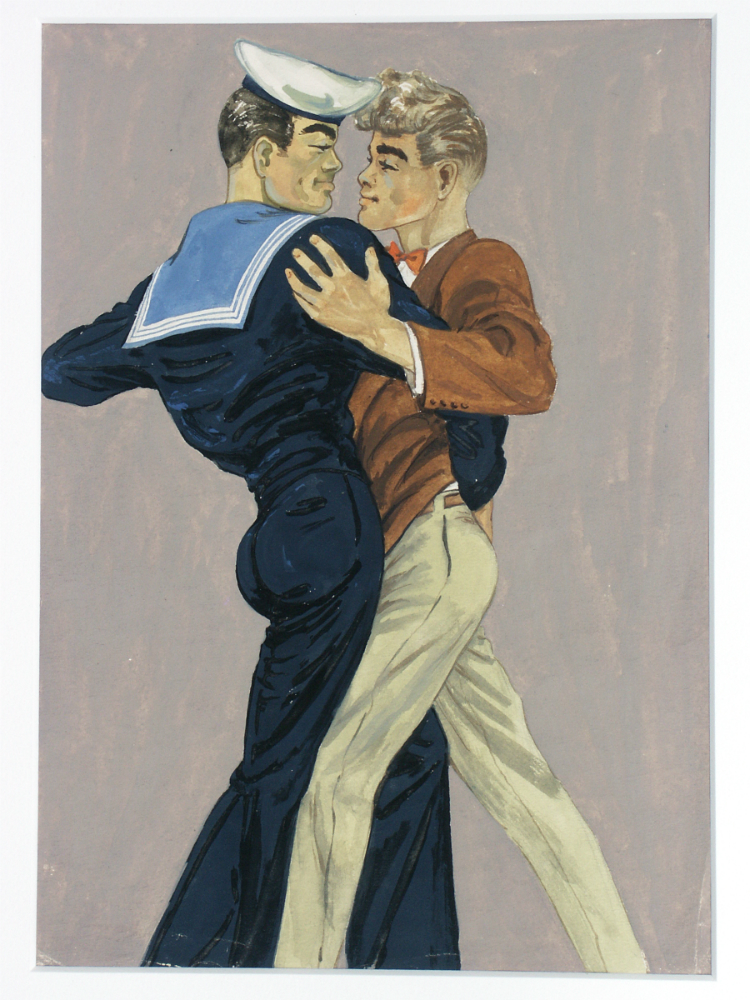kim? Contemporary Art Centre has the honor to announce the cooperation with LGBT and their friends association Mozaīka in the framework of the cultural program of the upcoming Europride2015 and to invite you to a two-piece performance – a reading by the Berlin based Latvian curator Kaspars Vanags and a presentation by the director and curator of Homotopia Liverpool Gary Everett on October 22 at 6.30pm, at the coworking space Birojnīca, in the Berga Bazārs.
The event will start a series of events for the forthcoming exhibition whose challenge and problematics have been announced thusly: how to create a visual arts event, the thematic accents of which have no precedents in the local cultural space? And – how to question the chances of the binary division (gender, sexual orientation) in the world of today and how to create the preconditions for reviewing the rest of the stereotypes by using unique historical references, among them the masculine and sexually charged presence of the gay art icon Tom of Finland?
In between the normative and the fantasy: what else does contemporary art have to say about sexual orientation?

Untitled. Tom of Finland. Gouache paper. 1947
©Tom of Finland® Foundation, Incorporated
With the dating classifieds’ transformation into cell phone applications, the relationship of sexuality and visual culture seem to have reached a new phase of intimacy. Selfies as a self-manipulated self-presentation on the oversaturated flesh market are a good example of how conditional is the divide between the normative and the fantasy in our understanding of our own and other’s sexuality. When „we just clicked” refers more to the computer’s keyboard than to the biochemistry of partnership, it is perhaps useful to look at the extent to which the traditional prejudices about sexuality have been replaced by fantasies about identity, including sexual identity, created in the context of the marketplace. The divide between the normative and the fantasy, which we see clearly in art only through a distance of time, has served in my presentation as an encouragment to compare the gender stereotypes seen in the illustrations of ou r childhood’s Zenta Ērgle novels with the forms of sexual identity’s self-representation of contemporary art today. Perhaps the drawings of Edgars Ozoliņš are not as innocent as they might seem.
– Kaspars Vanags
Kaspars Vanags (b.1970) is an art and culture theoretician. In the 90ties worked as a curator, together with like-minded thinkers in the fellowship Open organizing inter-disciplinary events, where he mixed visual art with trending rave music. Created projects in which art has a critical role of a social platform, turning against or creating an alternative to consumerism culture (Slideplays (2000); Subversion in the city (2001)). Later turned to studies of art history, obtained a degree in art history at the Courtauld Institute of Art. Lives in Berlin, where has worked as a maker of exhibitions and art critic. Curator of the Latvian exhibition in the next year’s Venice Biennale.

Untitled. Tom of Finland. Graphite on paper. 1957
©Tom of Finland® Foundation, Incorporated
Homotopia 10 years on presented by Gary Everett
20-25 minutes long PowerPoint presentation on how organization has developed and worked in partnership with major museums and galleries, exploring the role of cultural institutions, curators, and archivists in representing marginalized communities and promoting diversity and identifying under-representation of LGBT art, artistic practice and heritage in mainstream public spaces.
About Homotopia
Homotopia is run by Gary Everett, who is the current artistic director and also founded the organization. Started as a pilot project in 2004 the organization established itself as a key cultural highlight in Liverpool’s European Capital of Culture 2008 attracting national and international attention. The organization recently became regularly funded in Arts Council England’s National Portfolio 2012-2015.
Gary Everett is the founder and current artistic director at Homotopia Liverpool. He produces an annual festival and year round diverse heritage, art and participatory projects such as Project Triangle, Alternative Miss Liverpool, Idaho 50, and Grand Vogue Ball. He wrote and co-produced The Invisible Death of Michael, and is developing short digital projects in collaboration with Light Factory. He is interested in the intersection of art, activism and human rights, and also how education and gay/lesbian/transgender art and queer cultures can be developed. Gary works extensively in the UK and internationally with recent large scale projects in Finland, Sweden and Turkey. Recently he curated the year long Tom of Finland Retrospective as part of Turku’s European Capital of Culture 2011 which attracted record audiences of 90,000. Gary also presented and curated the same exhibition at Kulturhuset Stockholm in 2012. Currently curating a major new project on the life of Touko Laaksonen (Tom of Finland) which opens in Turku in 2017. In December 2013 he was judged 53rd in the 100 most influential LGBT people in Britain in the Independent on Sunday’s annual Pink List. In October 2013 Homotopia also won the Attitude Magazine Culture Award.
Europride2015
From June 15 to June 21, 2015, the main yearly European LGBT event shall be held in Riga – EuroPride 2015, the goal of which is to attract the attentio n of Latvian as well as wider European society to the questions and issues of human rights, including the rights of LGBT, which LGBT persons and their friends, family and supporters have to face. In the framework of EuroPride 2015 – Riga approximately 50 events connected to questions of human rights, culture, sports etc. shall take place.
The event will be held in Latvian and English. The entrance is free of charge.
























